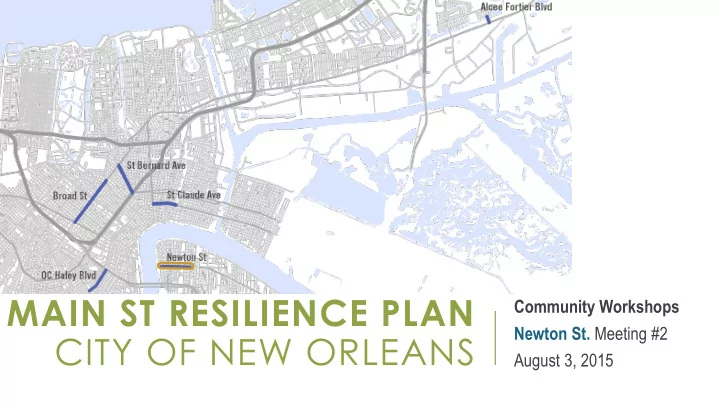

MAIN ST RESILIENCE PLAN Community Workshops Newton St. Meeting #2 CITY OF NEW ORLEANS August 3, 2015
AGENDA • Welcome & Introductions • Project Overview • Vulnerability Assessment Preliminary Findings • Shocks & Stresses • Infrastructure • Buildings • People • Discussion on Resiliency Strategies 2
Goals PROJECT OVERVIEW Schedule Community Engagement 3
PROJECT GOALS City Planning Commission 1. Developed a shared definition of resilient commercial corridors for New Orleans 2. Create a measurable and actionable methodology for assessing the resilience of commercial corridors or Metro-So Source, urce, llc llc Main Streets. 3. Apply methodology to 6 corridors (5 State-designated Main Streets), in the city and develop individualized recommendations for each to address resiliency gaps 4. Develop how-to guides for businesses for improving resiliency as applied to business operations and for businesses/property-owners for improving building resiliency 4
OVERVIEW OF PLANNING PROCESS • Defining Resilience for Main Streets March / April • Review Previous Efforts Initialization PAC Meeting #1 • Develop standardized assessment PAC Meeting #2 • Data collection (primary) May / June Assessment • Business occupant survey Corridor workshops 1 Business workshops • Commercial and residential market analysis July / August PAC Meeting #3 • Resilience gap analysis Analysis & • Infrastructure improvements and revitalization strategies Corridor workshops 2 Recommendations PAC Meeting #4 Community meetings • Technical guides: business operations & building hardening August / September • Draft and final plan; public presentations Final Plan Public presentations 5
Residential and Commercial Market WHAT WE’VE LEARNED Infrastructure / Built Environment Risk and Other Resilience Elements
ASSESSING A RESILIENT COMMERCIAL CORRIDOR • How vulnerable are corridor facilities and users to shock events • Does the corridor facilitate economic prosperity that can withstand times of stress? • Do corridor businesses have access, availability, and the capacity to engage resources needed to weather shocks & stresses? • Are adequate social networks in place to support corridor businesses during shocks and stresses? 7
ASSESSMENT: KEY POINTS • Despite historic lack of major storm damage, there are important vulnerabilities that should be addressed • Market primarily supports local, neighborhood focused businesses • Enhancing the customer base and improving the business environment should take advantage of existing conditions by focusing on housing opportunities and access • Prioritizing development nodes & catalytic projects could spark economic development • Crime is a major concern for the community. The perception of safety needs to be enhanced. 8
INFRASTRUCTURE & SHOCK EVENTS • Significant portion of corridor in Flood Zone • Low historic flood policy claim rate • Significant number of catch basins in below average or worse condition (54%) • Community has not identified storm damage as a major problem in past 9
BUILDINGS & SHOCK EVENTS • High proportion of: • Buildings on grade (71%) • Unprotected windows & doors (69%) • MEP not elevated (58%) • Strengths • Relatively low number of buildings in below average or worse condition (23%) • Few connected downspouts (2.7%) 71.0% Foundation on grade 69.0% Unprotected windows or doors 23.0% In 'below average' or worse condition 2.7% Connected Downspouts (lower is better, does not overload system) 58.0% MEP not elevated 10
MARKET ANALYSIS • Neighborhood-serving, locally owned, convenience market • Only major anchor is Federal City • Moderate unmet demand: • General Merchandise: $3.2 million • Electronics and Appliances: $2.3 million • Food Services and Drinking: $1.4 million • Clothing and Accessories: $1.4 million • Health Care and Personal Care: $1.3 million • 94% of people who work in area do not live there 11
PEOPLE Population Change, 2010-2015 Population immediately 12.0% surrounding Newton has grown 10.0% at a significantly slower pace 8.0% than the rest of the city 6.0% 4.0% 2.0% 0.0% Newton 0.1 Newton Newton 0.5 New Mile Radius 0.25 Mile Mile Radius Orleans Radius 12
HOUSING • Median home values are significantly lower than rest of city, and prices have not been rising as rapidly( 11% increase since 2009 near Newton vs. 32% citywide) • Rents are similar to city as a whole Median Home Value Median Rent $200,000 $780 $183,700 $150,000 $765 $765 $100,000 $105,859 $750 $754 $50,000 $- $735 Median Home Value Median Rent Newton 1/4 Mile New Orleans Newton 1/4 Mile New Orleans 13
HOUSING • More people rent near Newton, and rent is a higher percentage of household income than the rest of the city Own vs. Rent Homes Rent as Percentage of Income 40.0% 30.0% 47.3% 52.7% 20.0% 10.0% 64.4% 35.6% 0.0% Newton 1/4 Mile New Orleans 14
HOUSING • Vacancy by adjacent neighborhood: • Whitney: 25.3% • Behrman: 24.5% • McDonough: 35.4% • Algiers Point: 18.5% • US Naval Support Area: 17.6% 15
DISCUSSION: IMPROVING RESILIENCE
ENHANCE CUSTOMER BASE • Increase affordable housing opportunities near the corridor • Population growth significantly lower than rest of city • Housing costs lower than rest of city • Improve access to the corridor • Highlight connections to the ferry & MS River trail • Consider minor changes to bus routes to encourage travel to the corridor 17
IDENTIFY DEVELOPMENT OPPORTUNITIES • Nodes for priority investment • Important intersections, key blocks • Affordable property may encourage investment • Potential catalytic projects & development sites • Deep South Movie Studie • Blain Kern / Former Mardi Gras World • Vacant Properties, Light Industrial Sites • Coordinate with stakeholders to champion redevelopment • Federal City • Preservation Resource Center • NORA 18
INCREASE PERCEPTION OF SAFETY • Define & enhance public gathering spaces • Enhance relationships and develop formal arrangements among residents and businesses • Neighborhood watch or security district • Business Improvement District or Community Development Corporation 19
REDUCE VULNERABILITY TO SHOCKS • Develop and distribute building hardening guides • Significant portion of corridor is in flood zone • Most businesses are at grade (71%) • Emphasize need for continuity planning • Enhance buy-in, engagement 20
Tom Haysley – GCR THANK YOU thaysley@gcrincorporated.com Judith Dangerfield – Metro Source judithdangerfield@metro-source.com 21
Recommend
More recommend